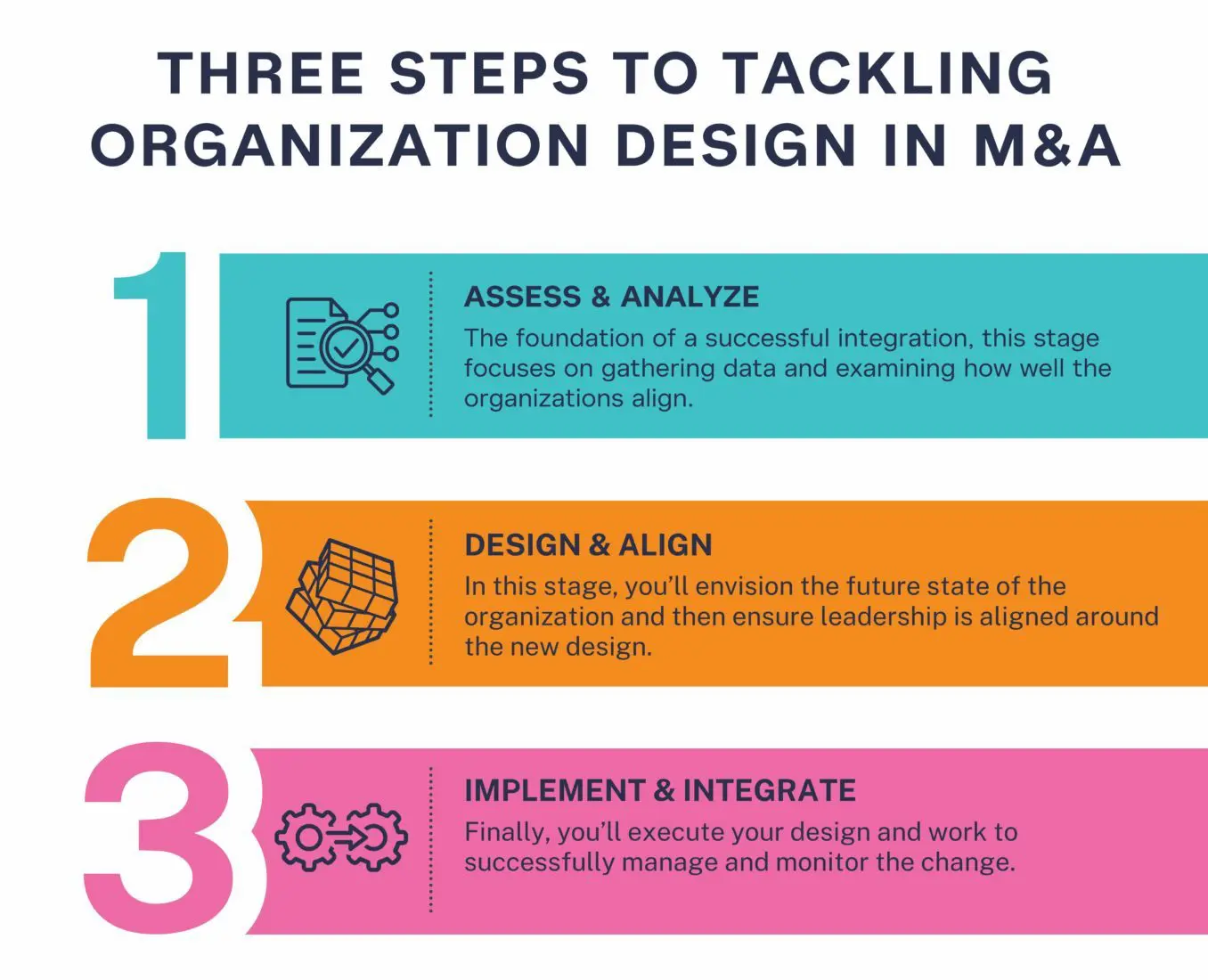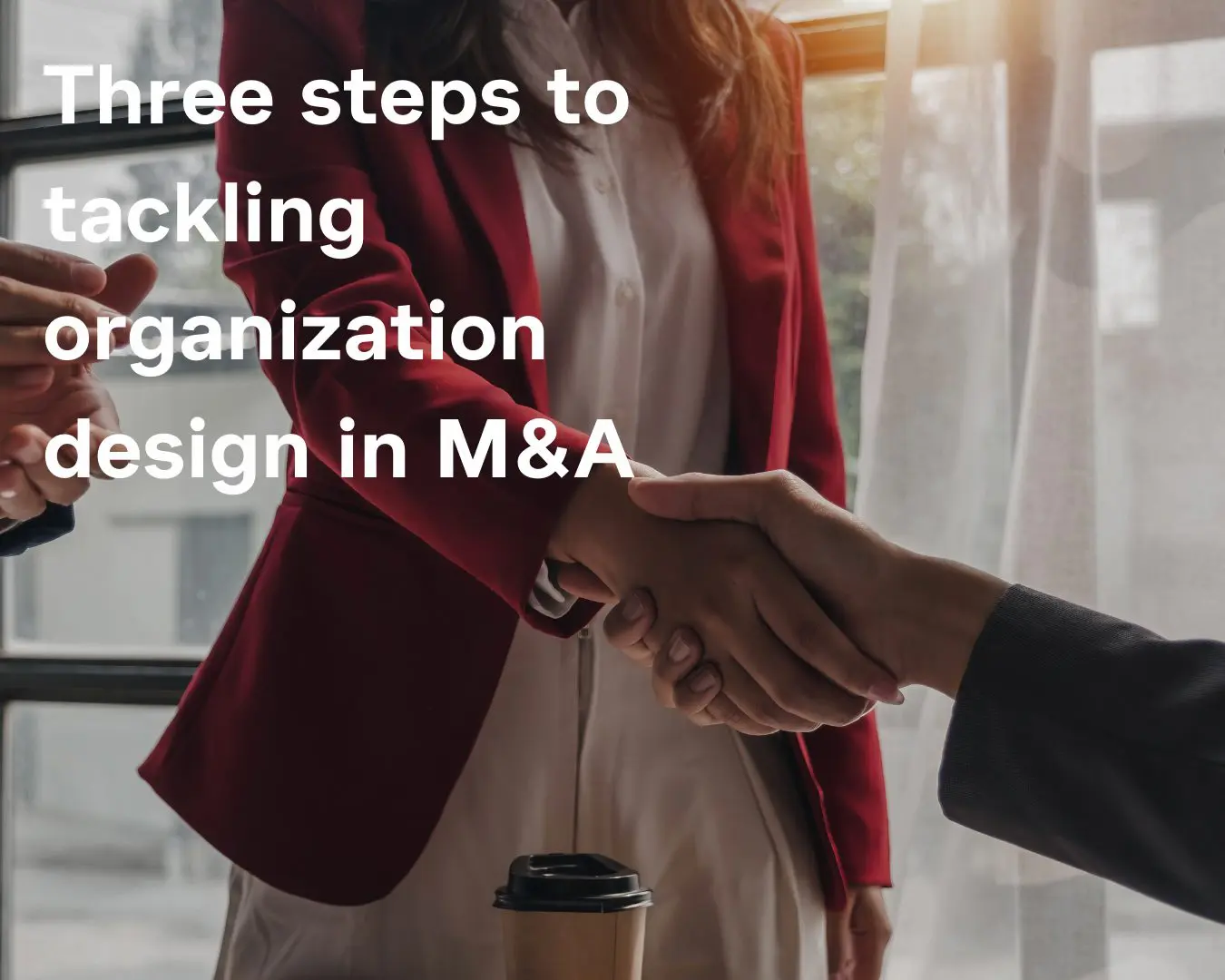Mergers and acquisitions (M&A) are complex endeavors that require meticulous planning and execution. Among the myriad considerations, organization design stands out as a critical factor that can determine the success or failure of the integration. For business leaders, CHROs, organization design professionals, and M&A teams, understanding the intricacies of organization design during M&A is essential. This blog post outlines a three-step approach to tackling organization design in M&A, offering insights and practical advice to guide you through the process.

Step 1: Assess & Analyze
The Foundation of Successful Integration
The first step in tackling organization design in an M&A scenario is conducting a thorough assessment and analysis. This stage focuses on gathering data and examining how well the two organizations align. Here’s a breakdown of what this entails:
- Deep Dive Into the People Data: Gather comprehensive data on job grades, compensation, organizational hierarchy, and other relevant metrics. This includes both quantitative data (e.g., employee headcount and financial metrics) and qualitative data (e.g., employee feedback and cultural assessments). A deep dive into people data is essential for understanding the workforce dynamics of both organizations.
- Opportunity Analysis: Compare the current state of both organizations to identify gaps and opportunities in areas impacted by the M&A. Compare spans, layers, job grades, and compensation levels. Look for areas where they complement each other and where redundancies or conflicts may exist. This is a great input into the organization’s design effort, grounding the team in the current state.
- Understand Current Organizing Choices: Examine various organizing choices, comparing your organization to the acquired one. Here are a few examples to illustrate this:
- Look at the differentiating capabilities. What business capabilities enable your organization to win in the marketplace? How are those the same (synergies) or different (potential unique value) from the acquired company?
- Compare pictures of the operating models. This picture tells a story about how the organization creates value. Identify the similarities and differences.
- Understand how work is grouped and placed. Is your organization highly centralized, and is the acquired organization very distributed?
- Scope Out the Design Effort: Using the data you have collected, determine the level of design required for each business unit and function. Outline the scope and objectives of the design effort. This includes defining key deliverables, timelines, resource requirements, pace and sequence.
Involving Cross-Functional Teams
Involving cross-functional teams from the business units, HR, finance, operations, and other relevant departments is crucial at this stage. This ensures comprehensive data collection and an accurate understanding of both organizations. Cross-functional collaboration also fosters a sense of ownership and alignment among key stakeholders.
Step 2: Design & Align
Envisioning the Future State
Once the assessment is complete, the next step is to design the future state of the organization. This stage involves aligning leadership on the new design, with varying levels of engagement depending on the complexity and scope of the integration. Here’s a detailed breakdown:
High-Touch Engagement
High-touch entails a full macro design, of the new combined organization. It is required when the operating models between the two companies are different, and decisions need to be made at the macro level. Key focuses include:
- Clarifying the combined value proposition. Does our expression of ‘how we win in the marketplace’ change with the integration of the acquisition?
- Developing a new combined operating model
- Determining top-level structure, roles , and decision rights
Middle-Touch Engagement
Targeted at the functional or business unit level, these sessions aim to align departmental goals with the overall vision. The emphasis is on:
- Understanding the impact on specific departments
- Aligning departmental strategies
- Identifying key integration areas such as functional or business unit structure, roles, decision rights and linkages across the organization
Low-Touch Engagement
For those business units and functions where there is minimal change or the change is primarily related to talent placement, a shorter design workshop is all it takes. Focus on roles and how they will change, integrating key processes, and general alignment.
Role of Design Workshops
Design workshops play a pivotal role in this stage, serving as a platform for interactive discussions that foster creativity and consensus. These workshops help in:
- Defining the unique differentiating capabilities from the acquired organization that must be protected and how that will happen
- Depicting a new combined operating model
- Outlining the merged organization’s structure
- Identifying how decision rights will be allocated
- Using the time together to reimagine the roles that the combined organization needs for success
HR’s Influence
HR plays a significant role in this stage, focusing on talent mapping and ensuring employees are aligned with roles matching their strengths and career aspirations. This ensures not only the technical success of the merger but also addresses the cultural and human aspects, paving the way for a united workforce ready to tackle future challenges together.
Step 3: Implement & Integrate
From Planning to Execution
The final stage is about execution and change management. This includes managing talent movement, work launch, technology enablement, and integrated program management. Key activities in this stage include:
- Change & Communications: Retaining critical talent is always a challenge during M&A. Be thoughtful about your plan, consider stay interviews as a change tactic during times of ambiguity, and strive to create an amazing employee experience for the incoming talent.
- Talent Movement: Manage employees’ redeployment to their new roles. Ensure clear communication about role changes and support employees through the transition.
- Work Launch: Initiate new workflows and processes. Provide training and resources to help employees adapt to new ways of working.
- Technology Enablement: Integrate IT systems and tools to support the new organizational structure. Ensure data continuity and system interoperability.
- Integrated Program Management: Oversee the implementation of the integrated plan. Track progress, identify risks and address them as they arise.
Ongoing Tracking and Monitoring
An essential part of this stage is ongoing tracking and monitoring to ensure successful implementation and capturing synergies. Regular communication, training, and support are crucial for a smooth transition and to mitigate any resistance or challenges. HR plays a vital role in managing employee morale and addressing concerns.
Don’t Go It Alone – Support Services Are Available
Navigating the complexities of organization design during an M&A process can be daunting. Fortunately, support services are available to help you through each stage. AlignOrg Solutions offers a comprehensive M&A Organization Design playbook. These services ensure that your organization is equipped with the expertise and resources needed to achieve successful integration, capturing the synergies expected and growing the value.
A Strategy for Success
Tackling organization design in M&A requires a strategic and methodical approach. By following the three steps—Assess & Analyze, Design & Align, and Implement & Integrate—you can navigate the complexities of integration and set your organization up for success. Remember, you don’t have to go it alone. Leverage support services to guide you through the process and ensure that your organization achieves its goals. With careful planning and execution, you can turn the challenges of M&A into opportunities for growth and transformation.
This is the final post in our three-part series on using smart organization design to maximize the success of your M&A. If you have a comment or question, or if you’d like to learn more about our M&A solutions, please contact us.



